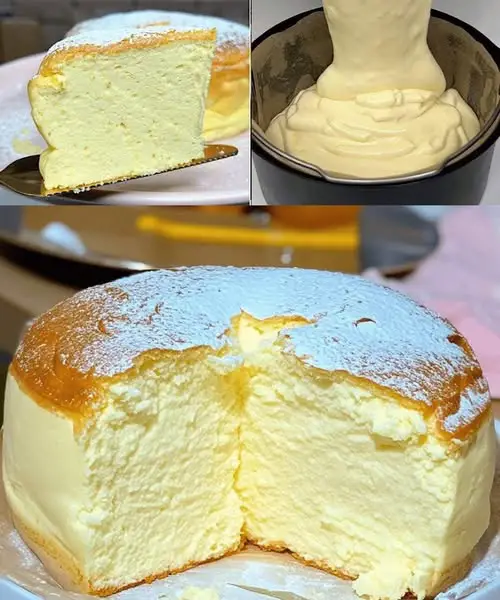Japanese Cheesecake, also known as Soufflé Cheesecake or Cotton Cheesecake, is one of the most delicate desserts in the world. Unlike classic dense New York cheesecake, this Japanese version is soft, airy, and jiggles beautifully when touched. It’s a wonderful blend of creamy richness and soufflé-like lightness.
In this full recipe, we’ll go through ingredients, step-by-step preparation, baking method, tips for success, variations, serving ideas, and storage instructions. By the end, you’ll feel confident making this delightful dessert at home.
Ingredients
For one 8-inch round Japanese Cheesecake:
Cream Cheese – 8 ounces (225g), softened
Unsalted Butter – 4 tablespoons (60g), softened
Egg Yolks – 6 large
Granulated Sugar – ⅓ cup (70g)
Milk – ½ cup (120ml), warm
Cake Flour – ⅔ cup (85g), sifted
Cornstarch – 2 tablespoons (16g)
Egg Whites – 6 large
Granulated Sugar for Meringue – ½ cup (100g)
Lemon Juice – 1 teaspoon (helps stabilize meringue)
Vanilla Extract – 1 teaspoon
Salt – a pinch
Optional toppings: powdered sugar, fresh berries, fruit compote, or whipped cream.
Equipment Needed
8-inch round springform or cake pan
Mixing bowls
Hand mixer or stand mixer
Whisk
Fine mesh sieve (for flour)
Spatula
Baking tray (for water bath)
Parchment paper
Step-by-Step Recipe
Step 1: Prepare the Pan
Grease the pan lightly with butter.
Line the bottom and sides with parchment paper.
Wrap the outside of the pan with aluminum foil to prevent water from seeping in during baking.
This step is crucial because Japanese cheesecake requires gentle baking in a water bath to stay moist and avoid cracks.
Step 2: Make the Cream Cheese Mixture
In a medium heatproof bowl, combine cream cheese, butter, and half of the milk.
Place the bowl over a pot of simmering water (double boiler method).
Stir until the mixture is smooth and lump-free.
Remove from heat and let it cool slightly.
This creates the creamy base of the cheesecake.
Step 3: Add Egg Yolks & Dry Ingredients
Whisk in the egg yolks, one at a time.
Add vanilla extract and a pinch of salt.
Sift in the cake flour and cornstarch, folding gently with a spatula.
Add the rest of the warm milk and mix until smooth.
At this stage, the mixture should be silky and slightly thick.
Step 4: Prepare the Meringue
In a large clean bowl, beat egg whites with lemon juice until foamy.
Gradually add ½ cup sugar in three additions, beating until stiff peaks form.
The meringue must be glossy and hold peaks but not dry. This is the secret to the cheesecake’s airy texture.
Step 5: Fold the Mixtures Together
Take one-third of the meringue and gently fold it into the cream cheese batter.
Add the remaining meringue in two batches, folding carefully with a spatula.
⚠️ Do not overmix! Overmixing will deflate the meringue and the cake won’t rise properly.
Step 6: Bake in a Water Bath
Pour the batter into the prepared pan.
Tap gently to remove air bubbles.
Place the pan in a larger baking tray filled with hot water (about 1 inch deep).
Bake at 320°F (160°C) for 25 minutes, then reduce to 285°F (140°C) and bake for another 45–50 minutes.
The cake should rise slowly and evenly without browning too quickly.
Step 7: Cool Gradually
Once baked, turn off the oven but leave the cheesecake inside with the door slightly open for 15 minutes.
This prevents sudden temperature shock and cracks.
Remove from oven and let cool at room temperature.
Step 8: Serve & Enjoy
Dust with powdered sugar.
Serve plain, or with fresh fruit and cream.
Slice gently with a warm knife to avoid tearing.
Tips for Success
Room temperature ingredients – Cream cheese, butter, and eggs must be softened for smooth mixing.
Stiff but not dry meringue – Over-beaten egg whites create lumps and won’t fold well.
Water bath is essential – Provides steam and prevents cracking.
Low and slow baking – Japanese cheesecake needs gentle heat to rise beautifully.
Don’t open the oven early – Sudden drops in temperature can cause collapse.
Patience in cooling – Let the cake cool gradually inside the oven to avoid shrinking.
Variations
Matcha Japanese Cheesecake – Add 1 tablespoon matcha powder to the flour.
Chocolate Soufflé Cheesecake – Add 2 tablespoons cocoa powder to the dry ingredients.
Lemon Japanese Cheesecake – Add 1 tablespoon lemon zest for freshness.
Marble Cheesecake – Swirl melted chocolate into the batter before baking.
Fruit-Infused Cheesecake – Top with strawberry, mango, or blueberry compote.
Serving Ideas
With powdered sugar dusting and fresh strawberries.
Alongside green tea or coffee.
As part of a dessert platter with macarons, cream puffs, or fruit tart.
Topped with whipped cream and chocolate shavings for a festive look.
Storage Instructions
Room Temperature: Best eaten within a few hours of baking.
Refrigerator: Store in an airtight container for up to 3 days.
Freezer: Wrap slices in cling film and freeze up to 1 month. Thaw in the fridge before serving.
Japanese Cheesecake vs. Classic Cheesecake
Texture: Japanese cheesecake is fluffy and airy, while classic cheesecake is dense and creamy.
Flavor: Japanese version is lighter and less sweet.
Technique: Japanese cheesecake requires a water bath and meringue, while New York cheesecake does not.
Final Thoughts
Making Japanese Cheesecake may seem intimidating, but once you understand the importance of meringue, water bath, and gentle baking, it becomes much easier. Each bite melts in your mouth like a soft cloud, making it one of the most satisfying cheesecakes in the world.

